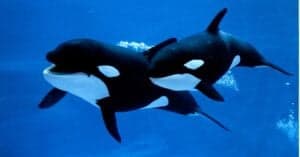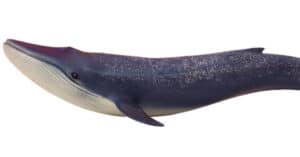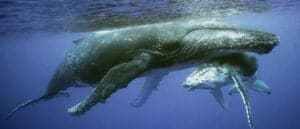Baby Narwhal: 10 Incredible Narwhal Fact & Incredible Pictures
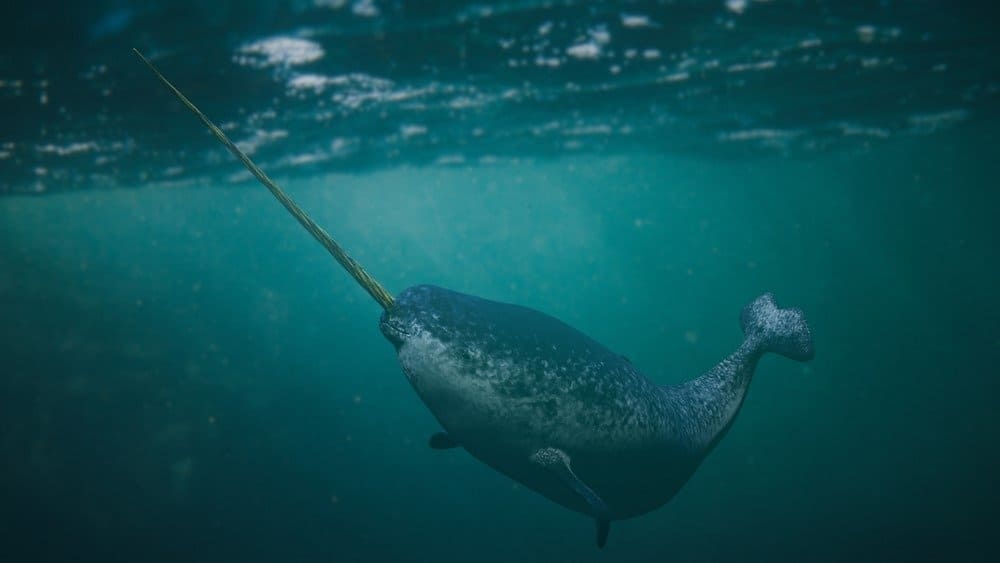
Dotted Yeti/Shutterstock.com
Narwhals have a life expectancy of 25 years on average; however, they can live up to 50 years. After six to eight years of age, females begin having babies, also known as calves. A narwhal gives birth to a baby after 14 months of gestation. Continue reading to find out more about baby narwhals!
1. What Are Baby Narwhals Called?

CampCrazy Photography/Shutterstock.com
Every three years, a narwhal gives birth to a baby, which is referred to as a calf in the scientific community.
2. How Much Does A Baby Narwhal Weigh?
Narwhal calves can weigh as much as 175 pounds when they are born. Adult males can weigh up to 4,000 pounds at their heaviest.
3. How Big Is A Baby Narwhal?
When narwhals are born, they are approximately five feet in length. Females achieve maturity at an estimated age of six to nine years when they reach an average length of approximately 11.5 feet.
4. What Do Baby Narwhals Look Like?
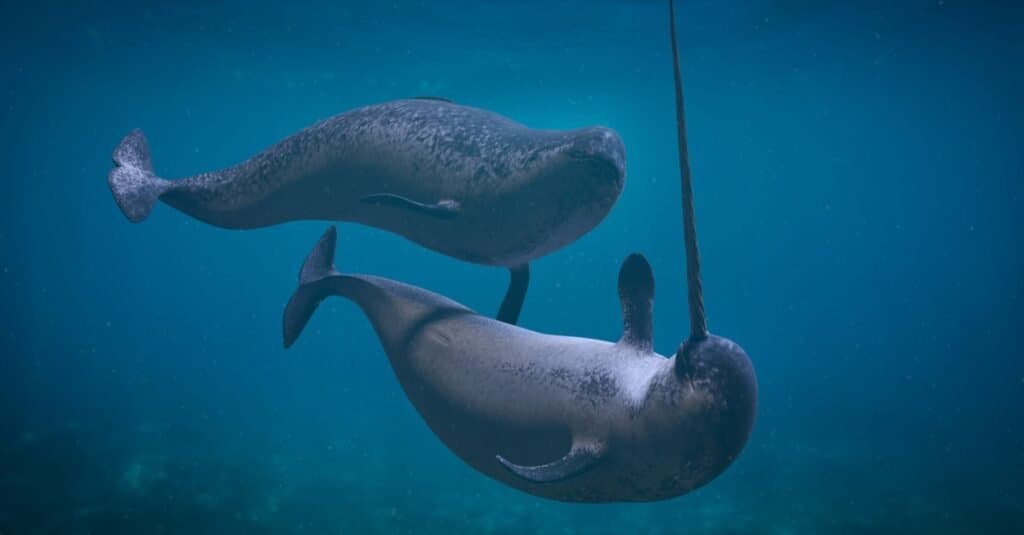
A thin layer of blubber forms on newborn narwhal calves as they nurse their mother’s milk, which is rich in fat. They are typically a speckled gray in color when born. They are the darkest when young and lighten up with age.
Male tail flukes, which are more like two wings attached to the tail flipper, have less sweep. This is thought to be an adaptation to counterbalance the male tusk’s drag.
5. Do Baby Narwhals Have Horns?
Male narwhal calves’ tusks develop slowly after birth and are not present at the time of birth.
6. What Do Baby Narwhals Eat?
For almost 20 months, calves are completely dependent on their mothers’ milk. If they stay near their mother, calves have plenty of opportunities to gain experience and survival strategies during nursing.
After nursing, they will go on to consume Greenland halibut, arctic and polar fish, squid, and shrimp. These creatures can be observed nibbling on the edges of ice floes and swimming in freezing waters during the summer.
7. How Long Does A Baby Narwhal Spend With Its Mother?

Obs70/Shutterstock.com
In its first 20 months of life, the calf spends most of its time with its mother. A calf is typically born in bays or inlets where the water is deep enough to accommodate the birth of the young animal.
Narwhal calves will remain with their mother and nurse for a year until becoming increasingly self-sufficient and joining the rest of the pod in the hunt for prey and food. Narwhals migrate in groups, as do many other types of whales, to avoid becoming separated from one another.
8. Can Narwhals Have Babies With Other Whales?

Alona K/Shutterstock.com
Narwhal-Beluga whale hybrids have been spotted on hunting missions for food, according to reports. The progeny of a beluga male and a narwhal female are these hybrids. At least three narwhal and beluga hybrids have been discovered.
It’s yet unclear if these hybrids can reproduce. In one hybrid hunted, the unusual skull traits showed that this whale fed on the seabed, like walruses, indicating distinct eating habits than that of either parent species.
9. What is the Most Common Cause Of Death In Baby Narwhals?
Starvation and orca predation are the most common causes of death in young narwhals.
10. How Long Do Narwhals Live?
Narwhals can live for up to 50 years and have a life expectancy of 25 years or higher.
In Conclusion
Narwhals are on the verge of extinction, and there is evidence of a drop in several of their subpopulations. Climate change has made narwhals one of the most vulnerable Arctic marine mammals. As sea ice melts, it is possible that climate change may expose more narwhals to the open ocean, increasing their vulnerability to poaching.
Narwhals must be safeguarded, their tusks must not be sold in the illicit wildlife trade together with those of other animals, and the effects of ice pack loss on their habitats, breeding sites, and hunting areas must be monitored.
More from A-Z Animals

Dotted Yeti/Shutterstock.com
Narwhals have a life expectancy of 25 years on average; however, they can live up to 50 years. After six to eight years of age, females begin having babies, also known as calves. A narwhal gives birth to a baby after 14 months of gestation. Continue reading to find out more about baby narwhals!
1. What Are Baby Narwhals Called?

CampCrazy Photography/Shutterstock.com
Every three years, a narwhal gives birth to a baby, which is referred to as a calf in the scientific community.
2. How Much Does A Baby Narwhal Weigh?
Narwhal calves can weigh as much as 175 pounds when they are born. Adult males can weigh up to 4,000 pounds at their heaviest.
3. How Big Is A Baby Narwhal?
When narwhals are born, they are approximately five feet in length. Females achieve maturity at an estimated age of six to nine years when they reach an average length of approximately 11.5 feet.
4. What Do Baby Narwhals Look Like?

A thin layer of blubber forms on newborn narwhal calves as they nurse their mother’s milk, which is rich in fat. They are typically a speckled gray in color when born. They are the darkest when young and lighten up with age.
Male tail flukes, which are more like two wings attached to the tail flipper, have less sweep. This is thought to be an adaptation to counterbalance the male tusk’s drag.
5. Do Baby Narwhals Have Horns?
Male narwhal calves’ tusks develop slowly after birth and are not present at the time of birth.
6. What Do Baby Narwhals Eat?
For almost 20 months, calves are completely dependent on their mothers’ milk. If they stay near their mother, calves have plenty of opportunities to gain experience and survival strategies during nursing.
After nursing, they will go on to consume Greenland halibut, arctic and polar fish, squid, and shrimp. These creatures can be observed nibbling on the edges of ice floes and swimming in freezing waters during the summer.
7. How Long Does A Baby Narwhal Spend With Its Mother?

Obs70/Shutterstock.com
In its first 20 months of life, the calf spends most of its time with its mother. A calf is typically born in bays or inlets where the water is deep enough to accommodate the birth of the young animal.
Narwhal calves will remain with their mother and nurse for a year until becoming increasingly self-sufficient and joining the rest of the pod in the hunt for prey and food. Narwhals migrate in groups, as do many other types of whales, to avoid becoming separated from one another.
8. Can Narwhals Have Babies With Other Whales?

Alona K/Shutterstock.com
Narwhal-Beluga whale hybrids have been spotted on hunting missions for food, according to reports. The progeny of a beluga male and a narwhal female are these hybrids. At least three narwhal and beluga hybrids have been discovered.
It’s yet unclear if these hybrids can reproduce. In one hybrid hunted, the unusual skull traits showed that this whale fed on the seabed, like walruses, indicating distinct eating habits than that of either parent species.
9. What is the Most Common Cause Of Death In Baby Narwhals?
Starvation and orca predation are the most common causes of death in young narwhals.
10. How Long Do Narwhals Live?
Narwhals can live for up to 50 years and have a life expectancy of 25 years or higher.
In Conclusion
Narwhals are on the verge of extinction, and there is evidence of a drop in several of their subpopulations. Climate change has made narwhals one of the most vulnerable Arctic marine mammals. As sea ice melts, it is possible that climate change may expose more narwhals to the open ocean, increasing their vulnerability to poaching.
Narwhals must be safeguarded, their tusks must not be sold in the illicit wildlife trade together with those of other animals, and the effects of ice pack loss on their habitats, breeding sites, and hunting areas must be monitored.


